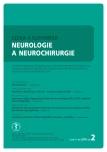REaDY – Czech Registry of Muscular Dystrophies
Authors:
J. Strenková 1; S. Voháňka 2; J. Haberlová 3; J. Junkerová 4; R. Mazanec 3; L. Mrázová 2; O. Parmová 2; P. Ridzoň 5; J. Staněk 4; D. Šišková 5; P. Vondráček 2; P. Brabec 1; L. Šnajdrová 1
Authors‘ workplace:
Institut biostatistiky a analýz MU, Brno
1; FN Brno
2; FN v Motole, Praha
3; FN Ostrava
4; Thomayerova nemocnice, Praha
5
Published in:
Cesk Slov Neurol N 2014; 77/110(2): 230-234
Category:
Short Communication
Projekt REaDY získal finanční podporu Ministerstva zdravotnictví v rámci 2. kola programu „Národní akční plány a koncepce“ na rok 2013.
Overview
Various forms of muscular dystrophies are mostly classified as rare diseases and rare diseases have received considerable attention from the European Union over the past few years. Based on the Council Recommendation of 8 June 2009 on an action in the field of rare diseases, the Czech government has embraced the National Action Plan on Rare Diseases, involving improvements in methodology of data collection on these diseases. The REaDY project (REgistry of muscular DYstrophy, http://ready.registry.cz) includes registries focusing on four types of neuromuscular disorders: Duchenne/Becker muscular dystrophy, spinal muscular atrophy, myotonic dystrophy, and facioscapulohumeral muscular dystrophy. As of 30th April 2013, REaDY registries contained data on 708 patients in total. Data from the REaDY project will lead to improvements in health care planning and predictions, including future estimates of financial costs, as well as costs and needs in the area of health technology (Health Technology Assessment, HTA). The costs are assessed from clinical data and from health care payers’ data.
Key words:
rare diseases – neuromuscular disorders – muscular dystrophies – clinical registries
The authors declare they have no potential conflicts of interest concerning drugs, products, or services used in the study.
The Editorial Board declares that the manuscript met the ICMJE “uniform requirements” for biomedical papers.
Sources
1. European Commission. Council Recommendation of 8 June 2009 on an action in the field of rare diseases (2009/ C 151/ 02). Official J Euro Commun 2009: 7– 10.
2. Vondráček P, Mrázová L, Haberlová J, Voháňka S, Brabec P, Strenková J. REaDY – REgistry of muscular DYstrophy. Dostupné z URL: http:/ / ready.registry.cz.
3. European Reference Networks for Rare Diseases. Dostupné z URL: http:/ / www.eurordis.org/ sites/ default/ files/ EURORDIS_Position_paper_on_ERN_May_2012.pdf.
4. TREAT‑ NMD global patient registries: A unified global source of information about neuromuscular patiens. Dostupné z URL: http:/ / www.treat‑ nmd.eu/ resources/ patient‑ registries/ overview/ .
5. Nadkarni PM, Brandt C, Frawley S, Sayward FG, Einbinder R, Zelterman D et al. Managing atribute – value clinical trials data using the ACT/ DB client‑ server database system. J Am Med Inform Assoc 1998; 5(2): 139– 151.
6. Nadkarni PM, Brandt CM, Marenco L. WebEAV: automatic metadata‑driven generation of web interfaces to entity‑ attribute‑ value databases. J Am Med Inform Assoc 2000; 7(4): 343– 356.
7. Nadkarni PM, Marenco L. Easing the transition between attribute‑ value databases and conventional databases for scientific data. Proc AMIA Symp 2001; 483– 487.
Labels
Paediatric neurology Neurosurgery NeurologyArticle was published in
Czech and Slovak Neurology and Neurosurgery

2014 Issue 2
Most read in this issue
- Autonomic Dysreflexia – a Serious Complication of Spinal Cord Injury
- Dravet Syndrome: Severe Myoclonic Epilepsy in Infancy – Case Reports
- Normative Values of Nerve Conduction Studies of the Ulnar and Median Nerves Measured in a Standardized Way
- Neuromodulation
